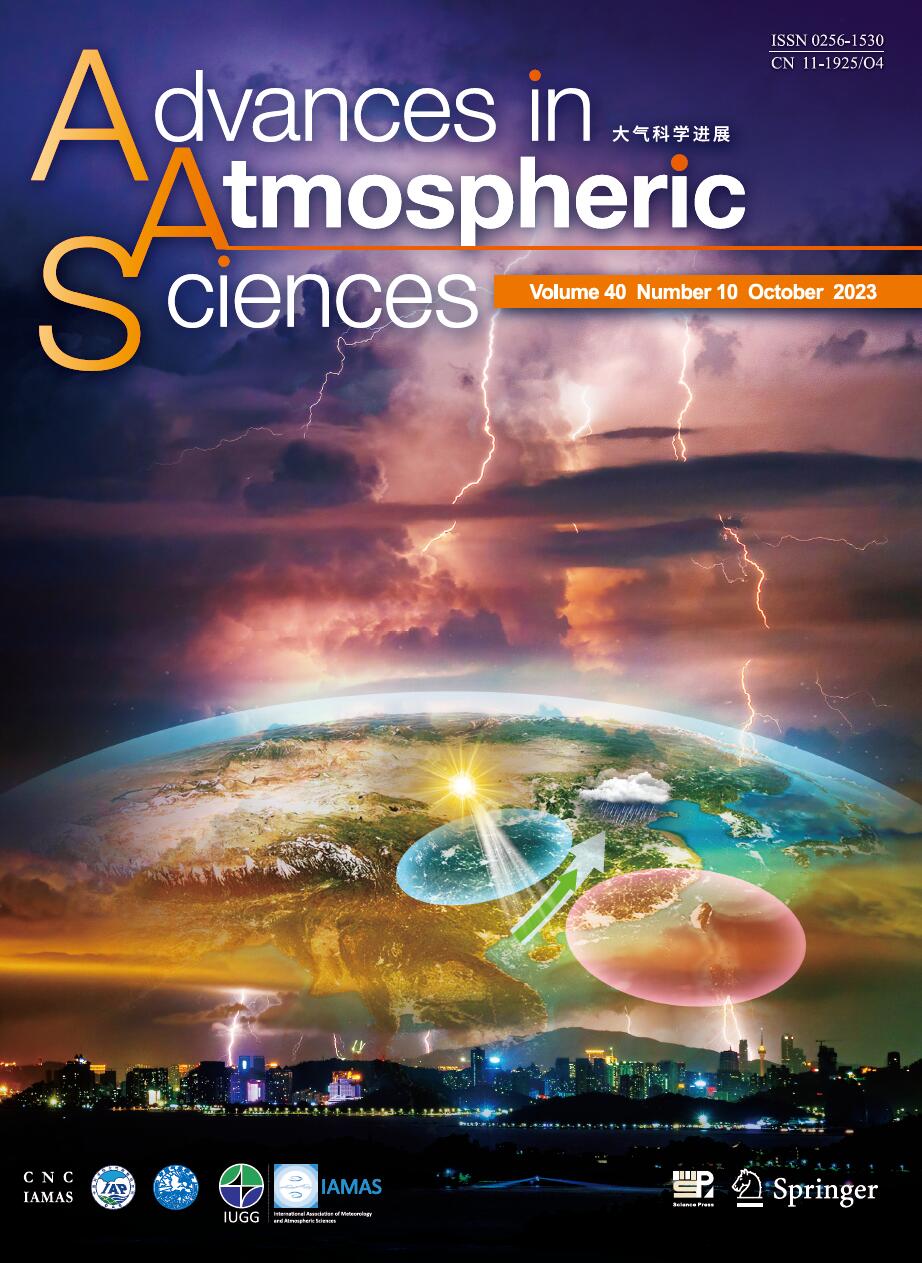| [1] |
YUE Caijun, SHOU Shaowen,
2008: A Modified Moist Ageostrophic Q Vector, ADVANCES IN ATMOSPHERIC SCIENCES, 25, 1053-1061.
doi: 10.1007/s00376-008-1053-x
|
| [2] |
Li Weiping, Theo Chidiezie Chineke, Liu Xin, Wu Guoxiong,
2001: Atmospheric Diabatic Heating and Summertime Circulation in Asia-Africa Area, ADVANCES IN ATMOSPHERIC SCIENCES, 18, 257-269.
doi: 10.1007/s00376-001-0018-0
|
| [3] |
ZHANG Xu, Hai LIN, JIANG Jing,
2012: Global Response to Tropical Diabatic Heating Variability in Boreal Winter, ADVANCES IN ATMOSPHERIC SCIENCES, 29, 369-380.
doi: 10.1007/s00376-011-1049-9
|
| [4] |
Luo Dehai, Ji Liren,
1989: The Role of Topography and Diabatic Heating in the Formation of Dipole Blocking in the Atmosphere, ADVANCES IN ATMOSPHERIC SCIENCES, 6, 173-185.
doi: 10.1007/BF02658014
|
| [5] |
YUE Caijun, SHOU Shaowen, LIN Kaiping, YAO Xiuping,
2003: Diagnosis of the Heavy Rain near a Meiyu Front Using the Wet Q Vector Partitioning Method, ADVANCES IN ATMOSPHERIC SCIENCES, 20, 37-44.
doi: 10.1007/BF03342048
|
| [6] |
LING Jian, LI Chongyin, ZHOU Wen, JIA Xiaolong, Chidong ZHANG,
2013: Effect of Boundary Layer Latent Heating on MJO Simulations, ADVANCES IN ATMOSPHERIC SCIENCES, 30, 101-115.
doi: 10.1007/s00376-012-2031-x
|
| [7] |
GAO Shouting, ZHOU Yushu, CUI Xiaopeng, DAI Guoping,
2004: Impacts of Cloud-Induced Mass Forcing on the Development of Moist Potential Vorticity Anomaly During Torrential Rains, ADVANCES IN ATMOSPHERIC SCIENCES, 21, 923-927.
doi: 10.1007/BF02915594
|
| [8] |
Yu ZHAO, Anmin DUAN, Guoxiong WU,
2018: Interannual Variability of Late-spring Circulation and Diabatic Heating over the Tibetan Plateau Associated with Indian Ocean Forcing, ADVANCES IN ATMOSPHERIC SCIENCES, 35, 927-941.
doi: 10.1007/s00376-018-7217-4
|
| [9] |
Yuanchang DONG, Guoping LI, Xiaolin XIE, Long YANG, Peiwen ZHANG, Bo ZENG,
2024: Mechanism of Diabatic Heating on Precipitation and the Track of a Tibetan Plateau Vortex over the Eastern Slope of the Tibetan Plateau, ADVANCES IN ATMOSPHERIC SCIENCES, 41, 155-172.
doi: 10.1007/s00376-023-2275-7
|
| [10] |
Luo Zhexian,
1987: ABRUPT CHANGE OF FLOW PATTERN IN BAROCLINIC ATMOSPHERE FORCED BY JOINT EFFECTS OF DIABATIC HEATING AND OROGRAPHY, ADVANCES IN ATMOSPHERIC SCIENCES, 4, 137-144.
doi: 10.1007/BF02677060
|
| [11] |
Wang Chunming, Wu Rongsheng, Wang Yuan,
2002: Interaction of Diabatic Frontogenesis and Moisture Processes in Cold-Frontal Rain-Band, ADVANCES IN ATMOSPHERIC SCIENCES, 19, 544-561.
doi: 10.1007/s00376-002-0085-x
|
| [12] |
WANG Pengyun, YANG Jing,
2003: Observation and Numerical Simulation of Cloud Physical Processes Associated with Torrential Rain of the Meiyu Front, ADVANCES IN ATMOSPHERIC SCIENCES, 20, 77-96.
doi: 10.1007/BF03342052
|
| [13] |
Donald R. Johnson, Zhuojian Yuan,
1999: The Role of Diabatic Heating, Torques and Stabilities in Forcing the Radial-Vertical Circulation within Cyclones Part III: Case Study of Lee-side Cyclones, ADVANCES IN ATMOSPHERIC SCIENCES, 16, 31-63.
doi: 10.1007/s00376-999-0003-6
|
| [14] |
Zhuojian Yuan, Donald R. Johnson,
1998: The Role of Diabatic Heating, Torques and Stabilities in Forcing the Radial-Vertical Circulation within Cyclones Part II: Case Study of Extratropical and Tropical Cyclones, ADVANCES IN ATMOSPHERIC SCIENCES, 15, 447-488.
doi: 10.1007/s00376-998-0026-4
|
| [15] |
Shou Shaowen, Liu Yaohui,
1999: Study on Moist Potential Vorticity and Symmetric Instability during a Heavy Rain Event Occurred in the Jiang-Huai Valleys, ADVANCES IN ATMOSPHERIC SCIENCES, 16, 314-321.
doi: 10.1007/BF02973091
|
| [16] |
Wang Huijun,
1997: The Effect of Heating Anomaly on the Asian Circulation-A GCM Experiment, ADVANCES IN ATMOSPHERIC SCIENCES, 14, 81-86.
doi: 10.1007/s00376-997-0046-5
|
| [17] |
Gang LI, Daoyong YANG, Xiaohua JIANG, Jing PAN, Yanke TAN,
2017: Diagnosis of Moist Vorticity and Moist Divergence for a Heavy Precipitation Event in Southwestern China, ADVANCES IN ATMOSPHERIC SCIENCES, 34, 88-100.
doi: 10.1007/s00376-016-6124-9
|
| [18] |
Na LI, Lingkun RAN, Shouting GAO,
2016: The Impact of Deformation on Vortex Development in a Baroclinic Moist Atmosphere, ADVANCES IN ATMOSPHERIC SCIENCES, 33, 233-246.
doi: 10.1007/s00376-015-5082-y
|
| [19] |
Zuohao CAO, Da-Lin ZHANG,
2004: Tracking Surface Cyclones with Moist Potential Vorticity, ADVANCES IN ATMOSPHERIC SCIENCES, 21, 830-835.
doi: 10.1007/BF02916379
|
| [20] |
Xie Yibing,
1984: OBSERVATIONAL AND THEORETICAL STUDIES OF THE MOIST BAROCLINIC ATMOSPHERE, ADVANCES IN ATMOSPHERIC SCIENCES, 1, 141-164.
doi: 10.1007/BF02678127
|















 AAS Website
AAS Website 
 AAS WeChat
AAS WeChat 
 DownLoad:
DownLoad: